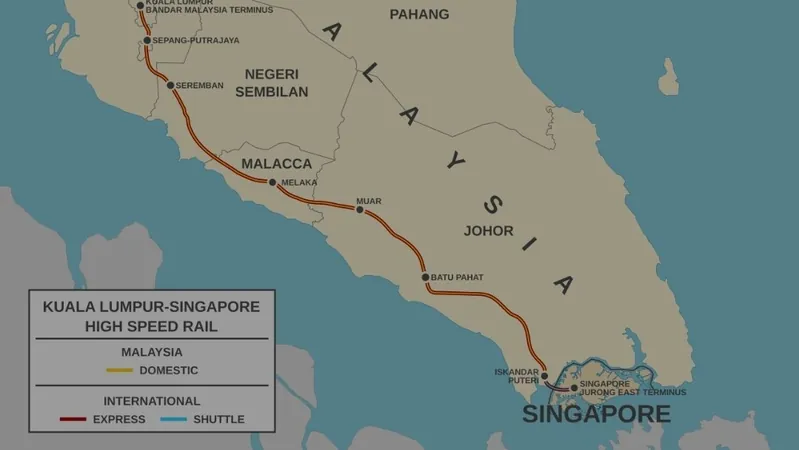
Shocking Withdrawal: MRCB Exits High-Speed Rail Project Between Kuala Lumpur and Singapore! What’s Next?
2025-01-02
Author: Ming
In a surprising twist, Malaysian Resources Corporation Bhd (MRCB) has officially stepped back from the ambitious Kuala Lumpur-Singapore high-speed rail (HSR) project. This strategic withdrawal underscores the company's commitment to financial prudence amid a climate of economic uncertainty and the inherent risks associated with large infrastructure endeavors.
Industry analysts are interpreting MRCB's decision as a calculated strategy designed to safeguard long-term shareholder interests and foster sustainable growth, rather than a mere retreat from the project. The HSR, which promised to revolutionize regional connectivity with planned stops across both Malaysia and Singapore, has encountered a plethora of challenges since its launch in 2013. Political shifts and changing governmental priorities have contributed to significant delays, including the project's abrupt termination under the Pakatan Harapan government back in 2018.
While the HSR project remains a goal for both nations—discussions about reviving it are ongoing—the financial and governance risks tied to such megaprojects remain daunting. MRCB’s exit, following growing speculation about rival bids from companies like YTL Construction and SIPP Rail, represents a significant shift in the balance of power within the consortium initially led by Berjaya Group.
Financial analysts suggest that MRCB's strategic retreat is firmly rooted in a detailed risk assessment. This move shields the company and key stakeholders, including prominent investors such as the Employees Provident Fund and Retirement Fund Inc (KWAP), from the potential financial drain of continued involvement in such risky ventures. After all, large-scale infrastructure projects demand hefty upfront investments and long-term commitments—a reality that has become even more complicated with the HSR's history of delays.
Yet, while MRCB's exit marks a chapter closing in the HSR development phase, it leaves the door open for future involvement in the high-speed project's broader ecosystem. Experts predict that MRCB may pivot towards downstream opportunities, utilizing its robust experience in transit-oriented development (TOD), property management, and retail operations as the project moves closer to less risky operational phases.
MRCB's history of successfully spearheading projects like Kuala Lumpur Sentral, one of Malaysia’s largest transit hubs, places it in a favorable position for any opportunities that may arise as the HSR progresses toward operational functionality. The company’s expertise in intertwining urban development with transportation systems will be invaluable for future collaborations within Malaysia’s ever-evolving transportation landscape.
Originally, the HSR was set for a 2026 launch, aimed at connecting major cities in Malaysia, including Putrajaya, Negeri Sembilan, Melaka, and Johor. However, political and economic dynamics led to a gradual suspension of the project and its ultimate cancellation in 2018. Malaysia had to compensate Singapore S$102.8 million for preliminary expenses incurred before halting the project.
With MRCB's official withdrawal, the consortium now comprises Berjaya Rail Sdn Bhd, Keretapi Tanah Melayu Bhd, IJM Corp Bhd, Deutsche Bahn, Hitachi Rail, and Hyundai Rotem. These companies are persevering in exploring development opportunities within the HSR initiative, intent on navigating the complicated landscape of risks and uncertainties that lie ahead.
As analysts reflect on this significant move, they underscore the need for a careful balance between ambitious infrastructure projects and effective risk management. What will this mean for the future of high-speed rail in the region? One thing is sure: the story of the Kuala Lumpur-Singapore HSR project is far from over! Stay tuned as we continue to cover this evolving saga!


 Brasil (PT)
Brasil (PT)
 Canada (EN)
Canada (EN)
 Chile (ES)
Chile (ES)
 Česko (CS)
Česko (CS)
 대한민국 (KO)
대한민국 (KO)
 España (ES)
España (ES)
 France (FR)
France (FR)
 Hong Kong (EN)
Hong Kong (EN)
 Italia (IT)
Italia (IT)
 日本 (JA)
日本 (JA)
 Magyarország (HU)
Magyarország (HU)
 Norge (NO)
Norge (NO)
 Polska (PL)
Polska (PL)
 Schweiz (DE)
Schweiz (DE)
 Singapore (EN)
Singapore (EN)
 Sverige (SV)
Sverige (SV)
 Suomi (FI)
Suomi (FI)
 Türkiye (TR)
Türkiye (TR)
 الإمارات العربية المتحدة (AR)
الإمارات العربية المتحدة (AR)